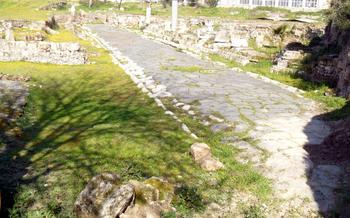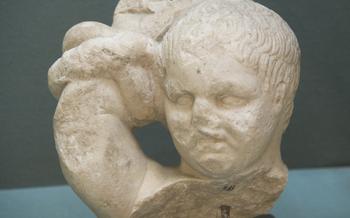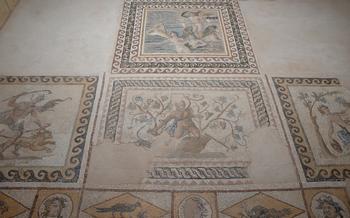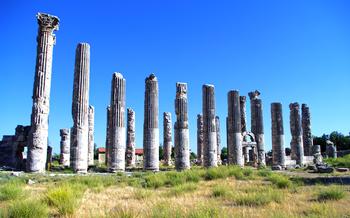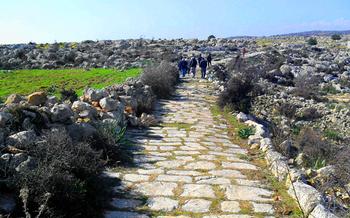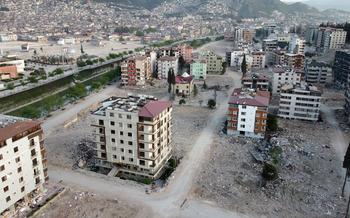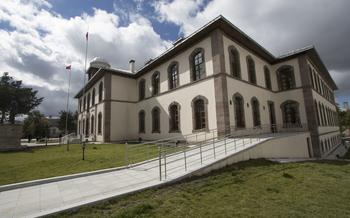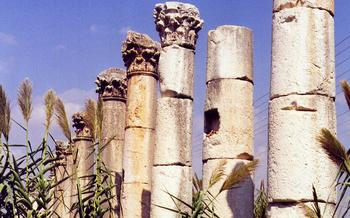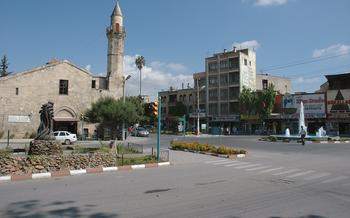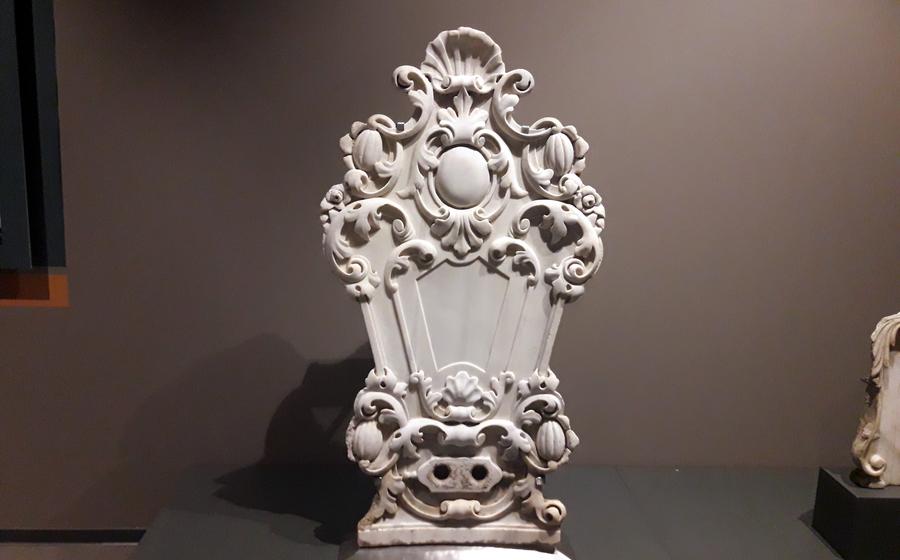
Mersin Archaeology Museum
- Explore Mersin's Ancient History at the Archaeology Museum
- Location and Accessibility
- Museum Layout and Galleries
- Ancient Artifacts and Collections
- Mersin's Archaeological Treasures
- Interactive Displays and Multimedia
- Guided Tours and Educational Programs
- Research Facilities and Library
- Museum Shop and Souvenirs:
- Accessibility for All
- Photography and Social Media
- Museum Hours and Admission Fees
- Nearby Attractions and Activities
- Food and Beverage Options
- Insider Tip:
Explore Mersin's Ancient History at the Archaeology Museum
The Mersin Archaeology Museum stands as a testament to the rich and storied past of this ancient port city. Its collection of artifacts unearthed through meticulous archaeological excavations paints a vivid picture of Mersin's significance throughout history. From the Neolithic era to the Roman and Byzantine periods, the museum offers a captivating journey through time, shedding light on the lives and cultures that have shaped this region.
The museum's exhibits are not merely relics of the past but also keys to understanding the evolution of human civilization. They reveal the artistry, ingenuity, and resilience of the people who called Mersin home. As you wander through the galleries, you'll discover ancient pottery, intricate sculptures, exquisite jewelry, and tools that tell the story of everyday life in Mersin.
The Mersin Archaeology Museum is a treasure trove of historical wonders, a place where the past comes alive. It serves as a guardian of Mersin's cultural heritage, ensuring that future generations can marvel at the achievements of their ancestors.
Location and Accessibility
The Mersin Archaeology Museum is strategically situated in the heart of Mersin city, making it easily accessible to visitors. Its exact address is:
Mersin Arkeoloji Müzesi, Kazım Karabekir Bulvarı No: 1, 33030 Mersin Merkez/Mersin
To get to the museum, you can either take public transportation or drive your own vehicle. There are several bus lines that stop near the museum, and the nearest tram station is just a short walk away. If you prefer to drive, there is ample parking space available in the vicinity of the museum. However, it's important to note that parking regulations may apply, so be sure to check the signs before leaving your car.
Museum Layout and Galleries
The Mersin Archaeology Museum boasts a well-organized and informative layout, guiding visitors through different sections and galleries that showcase the rich history of the region. Upon entering, you'll find yourself in the main hall, which provides an overview of the museum's collections and highlights. From here, you can venture into various galleries, each dedicated to a specific era or theme.
The chronological arrangement of exhibits allows you to trace the development of Mersin's past from prehistoric times to the Islamic period. As you move through the galleries, you'll encounter artifacts from different civilizations that have shaped the region's history, including the Hittites, Romans, Byzantines, and Ottomans.
Thematic galleries focus on specific aspects of Mersin's culture and history. One gallery, for example, showcases the region's rich maritime heritage, with exhibits on ancient seafaring, shipwrecks, and underwater archaeological discoveries. Another gallery highlights the diverse religious traditions that have flourished in Mersin, showcasing artifacts from various religious sites and practices.
Throughout the museum, you'll find informative displays that provide context and background information on the artifacts. These displays often include maps, timelines, and multimedia presentations that enhance the visitor experience and bring the past to life.
Ancient Artifacts and Collections
The Mersin Archaeology Museum houses a treasure trove of ancient artifacts that provide a glimpse into the rich history of the region. Among the most notable exhibits are the Neolithic pottery unearthed from the nearby site of Çatalhöyük, an ancient settlement that dates back to 7500 BC. These intricately painted ceramics offer insights into the artistic and cultural traditions of early civilizations in the area.
Of particular significance are the Bronze Age sculptures discovered at the site of Tarsus, an ancient city located just east of Mersin. These impressive statues, including the famous "Tarsus Man," depict human figures with remarkable detail and craftsmanship, showcasing the advanced artistic skills of the region's ancient inhabitants.
The museum also boasts an impressive collection of jewelry, tools, and other artifacts from various periods of history. These items, ranging from delicate gold earrings to bronze weapons, provide valuable clues about the daily lives, customs, and technologies of the people who lived in and around Mersin throughout the ages.
Explore the museum's galleries to discover the stories behind these fascinating artifacts and gain a deeper understanding of the rich history and cultural heritage of Mersin and its surrounding region.
Mersin's Archaeological Treasures
Mersin Archaeology Museum houses a diverse collection of artifacts that showcase the rich cultural heritage of the region. Among its notable treasures are the Neo-Hittite sculptures from Karatepe, which date back to the 8th century BC. These impressive stone carvings depict gods, goddesses, and mythological creatures, providing valuable insights into the religious beliefs and artistic traditions of the ancient Hittites.
Another highlight is the collection of ancient mosaics discovered in various parts of Mersin, including the famous "Gypsy Girl" mosaic from the Roman city of Soli-Pompeiopolis. This exquisite mosaic portrays a young woman with intricate jewelry and a vibrant expression, capturing the essence of Hellenistic art and the multicultural influences of the region.
The museum also features a remarkable collection of ceramics and pottery from different periods, including the Chalcolithic, Bronze Age, and Iron Age. These artifacts showcase the development of ceramic techniques and decorative styles in the region, providing valuable information about the daily lives and artistic expressions of ancient civilizations.
Furthermore, the museum displays an impressive collection of bronze and iron tools, weapons, and jewelry. These artifacts shed light on the technological advancements, metallurgy skills, and craftsmanship of the ancient inhabitants of Mersin.
The Mersin Archaeology Museum's collection is significant in understanding the cultural heritage and historical development of the region. These artifacts offer a tangible connection to the past, enabling visitors to explore the diverse civilizations that have shaped the rich tapestry of Mersin's history.
Interactive Displays and Multimedia
The Mersin Archaeology Museum embraces technology to enhance the visitor experience and provide a deeper understanding of the artifacts and historical context. Interactive displays and multimedia presentations bring the ancient world to life, making the museum an engaging and educational destination for visitors of all ages.
One of the highlights of the museum is the virtual reality experience, which transports visitors back in time to ancient Mersin. Through this immersive technology, visitors can explore the city's bustling streets, witness historical events, and interact with virtual characters. This unique experience allows visitors to connect with the past in a truly unforgettable way.
In addition to the virtual reality experience, the museum also features interactive touchscreens and multimedia kiosks. These interactive displays provide detailed information about the artifacts, their significance, and the stories behind their discovery. Visitors can zoom in on high-resolution images, watch videos, and listen to audio guides to gain a deeper understanding of the museum's collection.
Through these interactive displays and multimedia presentations, the Mersin Archaeology Museum creates a dynamic and engaging experience that appeals to a wide range of visitors. Whether you're a history buff, a culture enthusiast, or simply looking for an interactive and educational experience, the Mersin Archaeology Museum has something to offer everyone.
Guided Tours and Educational Programs
The Mersin Archaeology Museum offers guided tours to enhance the visitor experience and provide deeper insights into the exhibits. These tours are led by knowledgeable experts who share their expertise on the historical significance of the artifacts and the region's rich cultural heritage. Visitors can choose from a variety of tour options, depending on their interests and time constraints.
Taking a guided tour is highly recommended, as it allows visitors to gain a more comprehensive understanding of the museum's collection and the stories behind the artifacts. The guides are passionate about their work and bring the exhibits to life with their engaging narratives. They can answer questions, provide additional context, and point out hidden details that might otherwise be missed.
In addition to guided tours, the museum also organizes educational programs and workshops for students, researchers, and interested individuals. These programs aim to promote a deeper understanding of archaeology, history, and cultural heritage. The museum collaborates with local universities and institutions to offer lectures, seminars, and hands-on workshops that delve into various aspects of the region's past.
These educational initiatives provide a platform for knowledge sharing, skill development, and fostering a sense of appreciation for the region's rich cultural heritage. Visitors are encouraged to inquire about upcoming programs and workshops to enhance their museum experience and gain a broader perspective on the history and archaeology of Mersin.
Research Facilities and Library
The Mersin Archaeology Museum boasts an extensive research library and archive, catering to scholars, researchers, and history enthusiasts. This invaluable resource houses an impressive collection of books, journals, and documents related to the archaeology and history of Mersin and the surrounding region. The library provides a quiet and conducive environment for research and study, allowing visitors to delve deeper into the region's rich cultural heritage. Access to the research facilities is granted upon registration and may require a valid academic ID or research permit. The museum's knowledgeable staff is always ready to assist researchers with their inquiries and guide them towards relevant resources. Whether you're a seasoned academic or a curious history buff, the Mersin Archaeology Museum's research facilities offer a wealth of information and insights into the region's captivating past.
Museum Shop and Souvenirs:
The Mersin Archaeology Museum houses a well-stocked museum shop that offers a variety of replicas, books, and souvenirs related to the exhibits. These items provide an opportunity for visitors to take home a piece of their museum experience and share the cultural heritage of Mersin with others.
The shop offers a range of replicas, including miniature sculptures, pottery, and jewelry inspired by ancient artifacts. These replicas are crafted with attention to detail and make excellent souvenirs for those who want to own a piece of history.
In addition to replicas, the museum shop also sells a selection of books and publications on archaeology, history, and the culture of Mersin. These books provide a deeper understanding of the region's rich past and are a valuable resource for researchers and history enthusiasts.
Visitors can also find a variety of souvenirs, such as postcards, magnets, and keychains featuring images of the museum's artifacts or the city of Mersin. These souvenirs are a great way to commemorate a visit to the museum and share the experience with friends and family.
By purchasing items from the museum shop, visitors not only take home a tangible reminder of their visit but also support the museum's preservation efforts. The revenue generated from the shop contributes to the museum's ongoing conservation and research projects, ensuring that these treasures continue to be preserved for future generations.
Accessibility for All
The Mersin Archaeology Museum is committed to providing an inclusive and accessible experience for all visitors. The museum features ramps and elevators to ensure that all levels are accessible to those with mobility impairments. Additionally, audio guides are available for visitors who are deaf or hard of hearing, providing a comprehensive and immersive experience for all. The museum's staff is also trained to assist visitors with disabilities, ensuring that everyone can enjoy and appreciate the museum's rich collection.
Photography and Social Media
The Mersin Archaeology Museum encourages visitors to capture and share their experiences through photography and social media. Visitors are generally allowed to take non-flash photographs for personal use. However, the use of tripods, professional cameras, and commercial photography may require prior permission from the museum administration.
When sharing photos on social media, visitors are encouraged to tag the museum's official accounts and use relevant hashtags to help promote the museum's cultural heritage. By doing so, visitors not only share their experiences but also contribute to raising awareness about the museum and its valuable artifacts.
Remember to be respectful of other visitors while taking photos and avoid disturbing ongoing activities or exhibits. By following these guidelines, you can help preserve the museum's artifacts and ensure a positive experience for all.
Museum Hours and Admission Fees
Plan your visit to the Mersin Archaeology Museum by checking the exact hours of operation, which may vary depending on the season. The museum typically follows a regular schedule, but it's advisable to consult their website or contact them directly for the most up-to-date information.
Admission fees for the Mersin Archaeology Museum are reasonable and designed to support the preservation and maintenance of this valuable cultural institution. Adult tickets usually have a standard price, while children and students may be eligible for discounted rates. Group discounts are also available for educational or organized tours.
Keep in mind that the museum may host special events or temporary exhibitions that require separate tickets or reservations. Check their website or inquire at the museum for more details to avoid any surprises.
Nearby Attractions and Activities
After immersing yourself in the history and culture of Mersin at the Archaeology Museum, take some time to explore the city's other attractions. Just a short walk away, you'll find the Mersin Marina, a vibrant hub of activity with stunning views of the Mediterranean Sea. Here, you can stroll along the promenade, admire the yachts, and indulge in a delicious seafood meal at one of the many restaurants.
For a taste of nature, head to the Mersin Botanic Garden, located just a few kilometers from the museum. This sprawling garden is home to a diverse collection of plants from around the world, including exotic flowers, towering trees, and lush green lawns. Take a leisurely walk through the garden and soak in the tranquility of nature.
If you're interested in more history and culture, visit the Mersin Ethnography Museum, which showcases traditional Turkish artifacts, textiles, and handicrafts. You'll learn about the region's rich heritage and gain insights into the daily lives of its people.
For a unique experience, take a boat trip to the nearby Kizkalesi Castle, a medieval fortress perched on a small island just off the coast of Mersin. Explore the castle's ancient ruins and enjoy stunning views of the Mediterranean Sea.
Food and Beverage Options
The Mersin Archaeology Museum offers a small cafe within its premises, providing visitors with a convenient option to grab a quick bite or a refreshing drink before or after their exploration of the museum. The cafe offers a selection of beverages, including hot and cold drinks, as well as light snacks and pastries. For a more extensive dining experience, visitors can explore the surrounding area, where they will find a variety of restaurants and cafes catering to different tastes and budgets.
Just a short walk from the museum, visitors can discover traditional Turkish cuisine at local restaurants, savoring flavorful kebabs, aromatic stews, and fresh seafood dishes. For a taste of international cuisine, there are several restaurants offering Italian, Chinese, and Lebanese specialties. Whether you're looking for a quick snack, a leisurely lunch, or a memorable dinner, the area surrounding the Mersin Archaeology Museum offers a diverse range of culinary delights for visitors to enjoy.
Insider Tip:
As you wander through the Mersin Archaeology Museum, take a moment to pause in front of the intricate mosaic depicting a hunting scene. This stunning artwork, discovered during excavations in the ancient city of Soli-Pompeiopolis, offers a glimpse into the region's rich artistic heritage. Imagine the skilled artisans who painstakingly crafted each tile, bringing to life the vibrant colors and dynamic figures that adorn this mosaic masterpiece. Don't miss this hidden gem, which provides a tangible connection to the artistry and craftsmanship of a bygone era.
